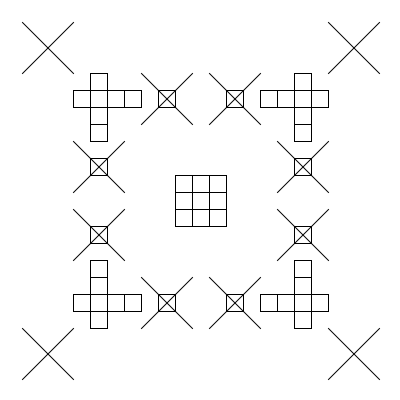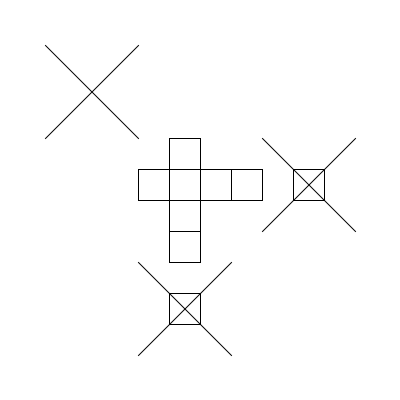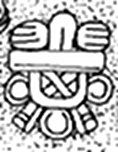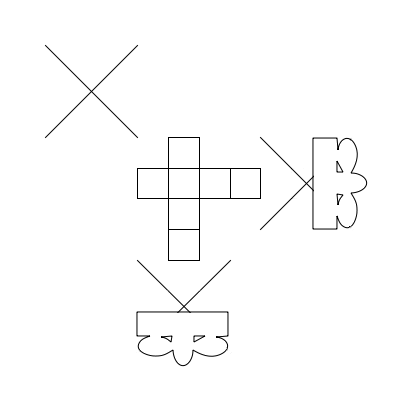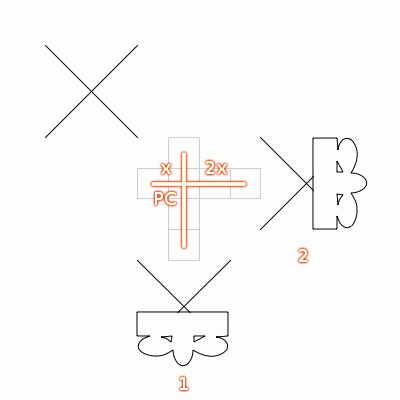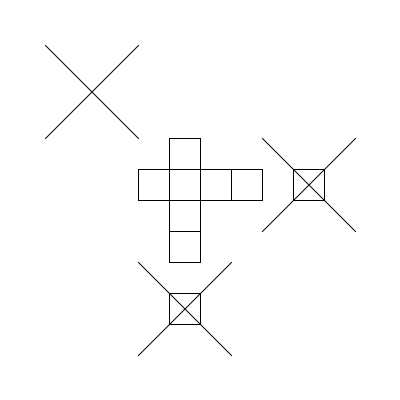The resulting state again, after performing all the transformation steps:
It's clear, that due to the rotations at the beginning there is a lot of redundancy in the image, and we will need only one quarter of it in the interpretation. The inner shape is also superfluous now, as it has already played its role by guiding us through the second half of the solving process. Let's remove these elements:
Here is the final figure, that we have to interpret, and that should in some way help us identify the other solar system:
Before interpreting it, we should recall, that the symbol for the other star(s) is originally not symmetrical (and was depicted so only for the sake of simplicity), but has a closing part on its upper side:
If we integrate these closing parts, with the proper directions, into the final figure, we get this picture:
This could reassure us again that the other stars are indeed looking into the direction of the Sun while they are separated from the other parts of the picture (that we have already removed). But, actually, what does this picture tell us, what could be the message it holds?
First of all, it appears to indicate, that the other system is a binary system consisting of two stars. Then, it is also likely, that the squares among the Sun and the other star(s) should measure the distance between them somehow. Of course, without any commonly definable and mutually agreeable absolute units (as it is the case when sending a message to an alien civilization), the only possible way to do this is to use a relative distance defined by some reference point. In the matter of our solar system and its nearby neighbors the most natural reference point (from our view) that comes to mind, is obviously the nearest star to the Sun, the Proxima Centauri, whose distance from us could serve as a cosmical unit for measuring other, larger distances. Certainly, with this method only very imprecise measurements can be performed, but in the absence of common absolute units this is the maximum we can have (and for making us aware of other civilizations near us it could also be more than enough).
It is fairly probable, that our final figure is indeed to be interpreted as a distance measurement of this type:
And, after "closing the scissor", we finally have the message that to reveal this whole long procedure seems to have been aimed at:
The final message: the other solar system, which served as the starting point for the interstellar travel, consists of two stars, and is three times as far away from us, as the nearest star, the Proxima Centauri.
Since the Proxima Centauri is about 4.24 light years from the Sun, the binary system we are looking for is located somewhere around the 13 ly distance. Based on this data the SCR 1845-6357 (12.57 ly) and the Kruger 60 (13.15 ly) systems could be the most promising candidates, but the Ross 614 (13.3 ly), the Wolf 424 (14.2 ly) and several other systems should also be considered. Of course, the distance in itself (especially determined by such a rough method) is not sufficient to choose the right one, a lot of other aspects needs to be examined, e.g. the type of the system, the number of the planets in it (according to the diagram it should have 3 inner and 3 outer planets), the possibility of life, etc.
But this is already a task for the future, and for now we can be completely satisfied with our result, as, apparently, we have in fact solved the code successfully!
In the final step we will review the transformation process in short, and draw our conclusions about the encoding method and the solution.

